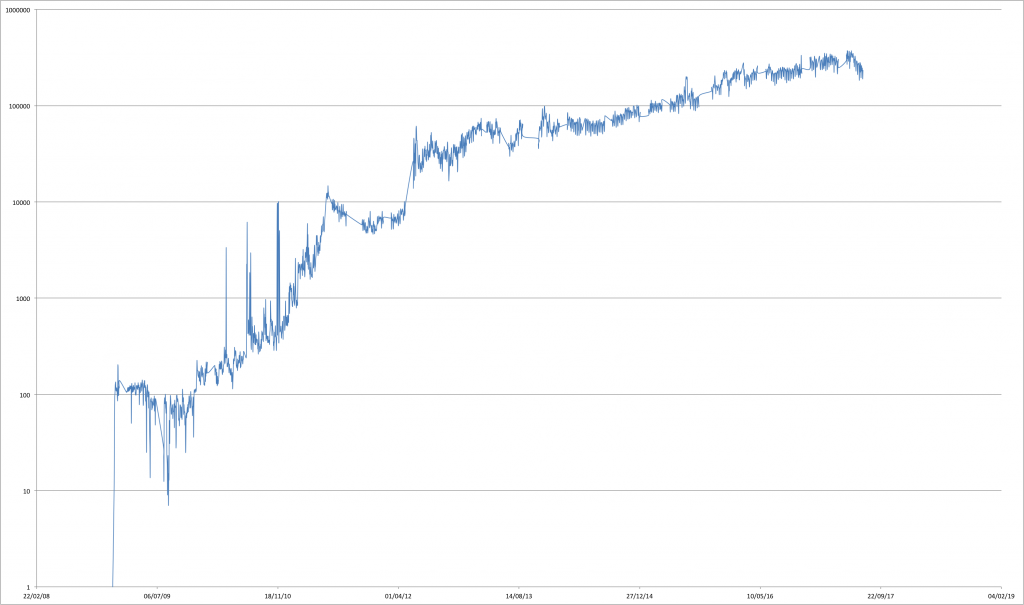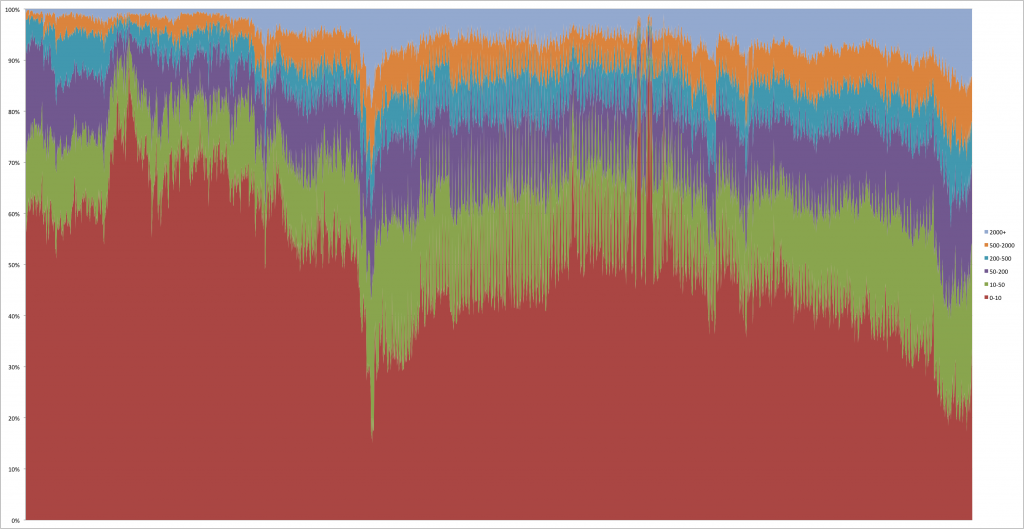你可以将区块链视为一个不断更新且可供所有人访问的大型数据库。你可以使用Bitcoin Core等软件下载完整的区块链。安装软件后,你的安装需要几周时间才能同步完成。请注意,在撰写本文时,区块链的大小超过130Gb,请考虑到这一点......
如果你有可用的区块链数据(不一定是整个区块链,你也可以使用它的子集),可以使用Java进行分析。你可以从头开始完成所有工作并从文件中读取原始数据等。让我们跳过此步骤并改为使用库。大多数编程语言都有几种选择。我将使用Java和bitcoinj库。这是一个大型库,可用于构建钱包,在线支付等应用程序。我将使用它的解析功能。
首先在https://bitcoinj.github.io/下载该库的jar文件(我正在使用https://search.maven.org/remotecontent?filepath=org/bitcoinj/bitcoinj-core/0.14.4/bitcoinj-core-0.14.4-bundled.jar)。然后,下载SLF4J,解压缩,然后获取名为slf4j-simple-x.y.z.jar的文件(在我的例子中:slf4j-simple-1.7.25.jar)。将这两个jar文件添加到类路径中,你就可以开始了。
让我们从一个简单的例子开始:计算(然后绘制)每天的交易数量。这是代码,注释很多。
monospace; font-size: 12px; display: block; padding: 0px; background: transparent; color: #c7254e; vertical-align: middle; border: none;" class="hljs cpp">import java.io.File;
import java.text.SimpleDateFormat;
import java.util.LinkedList;
import java.util.List;
import java.util.HashMap;
import java.util.Locale;
import java.util.Map;
import org.bitcoinj.core.Block;
import org.bitcoinj.core.Context;
import org.bitcoinj.core.NetworkParameters;
import org.bitcoinj.core.Transaction;
import org.bitcoinj.params.MainNetParams;
import org.bitcoinj.utils.BlockFileLoader;
public class SimpleDailyTxCount {
// Location of block files. This is where your blocks are located.
// Check the documentation of Bitcoin Core if you are using
// it, or use any other directory with blk*dat files.
static String PREFIX = "/path/to/your/bitcoin/blocks/";
// A simple method with everything in it
public void doSomething() {
// Just some initial setup
NetworkParameters np = new MainNetParams();
Context.getOrCreate(MainNetParams.get());
// We create a BlockFileLoader object by passing a list of files.
// The list of files is built with the method buildList(), see
// below for its definition.
BlockFileLoader loader = new BlockFileLoader(np,buildList());
// We are going to store the results in a map of the form
// day -> n. of transactions
Map<String, Integer> dailyTotTxs = new HashMap<>();
// A simple counter to have an idea of the progress
int blockCounter = 0;
// bitcoinj does all the magic: from the list of files in the loader
// it builds a list of blocks. We iterate over it using the following
// for loop
for (Block block : loader) {
blockCounter++;
// This gives you an idea of the progress
System.out.println("Analysing block "+blockCounter);
// Extract the day from the block: we are only interested
// in the day, not in the time. Block.getTime() returns
// a Date, which is here converted to a string.
String day = new SimpleDateFormat("yyyy-MM-dd").format(block.getTime());
// Now we start populating the map day -> number of transactions.
// Is this the first time we see the date? If yes, create an entry
if (!dailyTotTxs.containsKey(day)) {
dailyTotTxs.put(day, 0);
}
// The following is highly inefficient: we could simply do
// block.getTransactions().size(), but is shows you
// how to iterate over transactions in a block
// So, we simply iterate over all transactions in the
// block and for each of them we add 1 to the corresponding
// entry in the map
for ( Transaction tx: block.getTransactions() ) {
dailyTotTxs.put(day,dailyTotTxs.get(day)+1);
}
} // End of iteration over blocks
// Finally, let's print the results
for ( String d: dailyTotTxs.keySet()) {
System.out.println(d+","+dailyTotTxs.get(d));
}
} // end of doSomething() method.
// The method returns a list of files in a directory according to a certain
// pattern (block files have name blkNNNNN.dat)
private List<File> buildList() {
List<File> list = new LinkedList<File>();
for (int i = 0; true; i++) {
File file = new File(PREFIX + String.format(Locale.US, "blk%05d.dat", i));
if (!file.exists())
break;
list.add(file);
}
return list;
}
// Main method: simply invoke everything
public static void main(String[] args) {
SimpleDailyTxCount tb = new SimpleDailyTxCount();
tb.doSomething();
}
}
此代码将在屏幕上打印“日期,交易次数”形式的值列表。只需将输出重定向到文件并绘制它。你应该得到这样的东西(注意每日交易数量几乎呈指数增长):

我对这个库的性能印象非常深刻:使用上面的代码扫描整个区块链在我的笔记本电脑(2014 MacBook Pro)上花了大约35分钟,区块链存储在使用USB2端口连接的外部HD上。它最多占用了一个处理器和1 Gb RAM的大约100%。
一个稍微复杂的例子花了55分钟:计算交易规模的每日分布。这需要在上面的代码中添加另一个循环来检索所有交易输出(以及沿途的一些计数器)。区间是0-10美元,10-50美元,50-200美元,200-500美元,500-2000美元,2000+USD。

======================================================================
分享一些以太坊、EOS、比特币等区块链相关的交互式在线编程实战教程:
- java以太坊开发教程,主要是针对java和android程序员进行区块链以太坊开发的web3j详解。
- python以太坊,主要是针对python工程师使用web3.py进行区块链以太坊开发的详解。
- php以太坊,主要是介绍使用php进行智能合约开发交互,进行账号创建、交易、转账、代币开发以及过滤器和交易等内容。
- 以太坊入门教程,主要介绍智能合约与dapp应用开发,适合入门。
- 以太坊开发进阶教程,主要是介绍使用node.js、mongodb、区块链、ipfs实现去中心化电商DApp实战,适合进阶。
- C#以太坊,主要讲解如何使用C#开发基于.Net的以太坊应用,包括账户管理、状态与交易、智能合约开发与交互、过滤器和交易等。
- EOS教程,本课程帮助你快速入门EOS区块链去中心化应用的开发,内容涵盖EOS工具链、账户与钱包、发行代币、智能合约开发与部署、使用代码与智能合约交互等核心知识点,最后综合运用各知识点完成一个便签DApp的开发。
- java比特币开发教程,本课程面向初学者,内容即涵盖比特币的核心概念,例如区块链存储、去中心化共识机制、密钥与脚本、交易与UTXO等,同时也详细讲解如何在Java代码中集成比特币支持功能,例如创建地址、管理钱包、构造裸交易等,是Java工程师不可多得的比特币开发学习课程。
- php比特币开发教程,本课程面向初学者,内容即涵盖比特币的核心概念,例如区块链存储、去中心化共识机制、密钥与脚本、交易与UTXO等,同时也详细讲解如何在Php代码中集成比特币支持功能,例如创建地址、管理钱包、构造裸交易等,是Php工程师不可多得的比特币开发学习课程。
- tendermint区块链开发详解,本课程适合希望使用tendermint进行区块链开发的工程师,课程内容即包括tendermint应用开发模型中的核心概念,例如ABCI接口、默克尔树、多版本状态库等,也包括代币发行等丰富的实操代码,是go语言工程师快速入门区块链开发的最佳选择。
这里是原文用java简单分析下比特币区块链